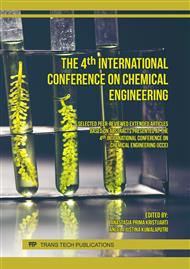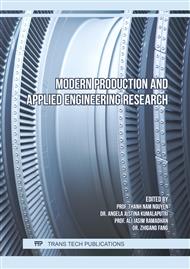p.97
p.105
p.117
p.129
p.141
p.151
p.163
p.175
p.181
Modeling and Simulation of Precipitation Process of Various Salt Components during Sea Salt Production
Abstract:
Salt is commonly produced from seawater by conventional solar evaporation process in Indonesia. Some of the salt produced has not been able to meet the standard requirement especially for industrial uses and make Indonesia still importing salt. This study aims to develop a precipitation model of various salt components during seasalt production from seawater by varying the brine input and output concentration on the crystallization table using the concept of solubility. The evaporation and precipitation processes during the salt production were modeled using a series of separator and filter units and carried out by making use of the electrolyte wizard in Aspen Plus®. In this simulation, 9 variation were carried out by varying the brine input at concentration 20 ºBe, 23 ºBe, and 25 ºBe and output at concentration 29 ºBe, 30 ºBe, and 31 ºBe on the crystallization table. It is shown that the purity of NaCl salt is significantly influenced by the the brine input concentration to and the brine output concentration from the crystallization table. The percentage of calcium impurity increases when the brine input concentration to the crystallization table is lower while the percentage of magnesium impurity increases when the brine output concentration from the crystallization table is higher. The percentage of sulfate impurity increases when both the brine input concentration to and the brine output concentration from the crystallization table is lower. In practice, it is advisable that the crystallization in the salt table is carried out from 25 to 29 ºBe to limit the amount of magnesium impurity that can cause salt to taste bitter. Conducting the crystallization in this concentration range would give the purity of NaCl salt of 94.049%, which is in accordance with SNI standard for consumption salt, and the yield of NaCl salt of 78.83%. Further study needs to be done to provide a workable solution on how to make the purity of NaCl salt higher such as by using suitable precipitating agents in the salt production to help the precipitation process of various salt impurities.
Info:
Periodical:
Pages:
141-150
Citation:
Online since:
May 2023
Authors:
Keywords:
Price:
Сopyright:
© 2023 Trans Tech Publications Ltd. All Rights Reserved
Share:
Citation:



